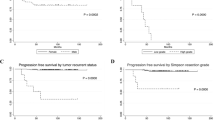Abstract
Spinal World Health Organization (WHO) II and III meningiomas are relatively rare, and often associated with great clinical aggressiveness and poor overall survival. There are controversies over factors affecting the prognosis of this disease. The aim of this retrospective study was to evaluate factors that may affect the therapeutic outcome and prognosis of adult high-grade spinal meningiomas by reviewing the medical records of 25 patients who were surgically treated in our hospital between 2001 and 2014. Univariate and multivariate analyses were performed to identify prognostic variables relative to patient and tumor characteristics, and treatment modalities. All 25 patients (14 men and 11 women; mean age 46.6 ± 16.1 years) underwent surgical resection. Local recurrence was occurred in 13 (52.0 %) patients, and 10 (40.0 %) patients died during the follow-up periods. The 5-year recurrence rate was 60.0 % and the 5-year survival rate was 68.0 %. The results of statistical analysis suggested that Simpson resection grade and the number of involved segments were prognostic factors related to progression-free survival and that sex, age, preoperative Frankel score, the number of involved segments and WHO grade were closely correlated with survival. Furthermore, we confirmed that the number of involved segments was the major independent factor affecting recurrence of patients with adult spinal high-grade meningiomas, and that sex, age and WHO grade were prognostic factors affecting survival but not recurrence.

Similar content being viewed by others
References
Russell DS, Rubinstein LJ (1989) Pathology of tumours of the nervous system, 5th edn. Arnold, London, pp 449–532
Helseth A, Mork SJ (1989) Primary intraspinal neoplasms in Norway, 1955 to 1986. A population-based survey of 467 patients. J Neurosurg 71:842–845
Sun SQ, Cai C, Ravindra VM et al (2015) Simpson grade I-III resection of spinal atypical (World Health Organization Grade II) meningiomas is associated with symptom resolution and low recurrence. Neurosurgery 76(6):739–746
Nakamura M, Tsuji O, Fujiyoshi K et al (2012) Long-term surgical outcomes of spinal meningiomas. Spine 37(10):E617–E623
Setzer M, Vatter H, Marquardt G et al (2007) Management of spinal meningiomas: surgical results and a review of the literature. Neurosurg Focus 23(4):E14
Maiuri F, De Caro ML, de Divitiis O et al (2011) Spinal meningiomas: age-related features. Clin Neurol Neurosurg 113(1):34–38
Sandalcioglu IE, Hunold A, Müller O et al (2008) Spinal meningiomas: critical review of 131 surgically treated patients. Eur Spine J 17(8):1035–1041
Louis DN, Ohgaki H, Wiestler OD et al (2007) The 2007 WHO classification of tumours of the central nervous system. Acta Neuropathol 114(2):97–109
Kshettry VR, Hsieh JK, Ostrom QT et al (2015) Descriptive epidemiology of spinal meningiomas in the United States. Spine 40(15):E886–E889
Frankel HL, Hancock DO, Hyslop G et al (1969) The value of postural reduction in the initial management of closed injuries of the spine with paraplegia and tetraplegia. I. Paraplegia 7:179–192
McCormick PC, Torres R, Post KD et al (1990) Intramedullary ependymoma of the spinal cord. J Neurosurg 72(4):523–532
Simpson D (1957) The recurrence of intracranial meningiomas after surgical treatment. J Neurol Neurosurg Psychiatry 20(1):22–39
Levy WJ Jr, Bay J, Dohn D (1982) Spinal cord meningioma. J Neurosurg 57:804–812
Solero CL, Fornari M, Giombini S et al (1989) Spinal meningiomas: review of 174 operated cases. Neurosurgery 25:153–160
Harkey HL, Crockard HA (1991) Spinal meningiomas: clinical features. In: Al-Mefty O (ed) Meningiomas. Raven Press, New York, pp 593–601
Schaller B (2005) Spinal meningioma: relationship between histological subtypes and surgical outcome? J Neurooncol 75(2):157–161
Bickerstaff ER, Rasmussen TB, Kernohan JW et al (1940) Pathologic classification, with surgical consideration, of intraspinal tumors. Ann Surg 111:513–530
Schoenberg BS, Christine BW, Whisnant JP (1975) Nervous system neoplasm and primary malignancies of other sites: the unique association between meningiomas and breast cancer. Neurology 25:705–712
Cohen-Gadol AA, Zikel OM, Koch CA et al (2003) Spinal meningiomas in patients younger than 50 years of age: a 21-year experience. J Neurosurg 98(3 Suppl):258–263
Sacko O, Haegelen C, Mendes V et al (2009) Spinal meningioma surgery in elderly patients with paraplegia or severe paraparesis: a multicenter study. Neurosurgery 64(3):503–509
Morandi X, Haegelen C, Riffaud L et al (2004) Results in the operative treatment of elderly patients with spinal meningiomas. Spine 29(19):2191–2194
Mawrin C, Perry A (2010) Pathological classification and molecular genetics of meningiomas. J Neurooncol 99(3):379–391
Lee KD, DePowell JJ, Air EL et al (2013) Atypical meningiomas: is postoperative radiotherapy indicated? Neurosurg Focus 35(6):E15
Westwick HJ, Yuh SJ, Shamji MF (2015) Complication avoidance in the resection of spinal meningiomas. World Neurosurg 83(4):627–634
Yamamuro K, Seichi A, Kimura A et al (2012) Histological investigation of resected dura mater attached to spinal meningioma. Spine 37(22):E1398–E1401
Acknowledgments
This study was supported by the Research Projects of Science and Technology Commission of Shanghai Municipality, China (13ZR1414200 ) and Research Projects of Health and Family planning Commission of Shanghai Municipality, China (2013210).
Author information
Authors and Affiliations
Corresponding authors
Ethics declarations
Conflict of interest
The authors declare no competing conflicts of interest.
Additional information
Jingliang Ye, Guoguang Lv and Jun Qian contributed equally to this work, and all should be considered first author.
Rights and permissions
About this article
Cite this article
Ye, J., Lv, G., Qian, J. et al. Clinical features and prognostic factors of WHO II and III adult spinal meningiomas: analysis of 25 cases in a single center. J Neurooncol 128, 349–356 (2016). https://doi.org/10.1007/s11060-016-2119-8
Received:
Accepted:
Published:
Issue Date:
DOI: https://doi.org/10.1007/s11060-016-2119-8




